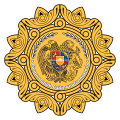رئيس أرمينيا
| ||||||||||||||||||||||||
| ||||||||||||||||||||||||
رئيس أرمينيا (بالأرمينية: Հայաստանի Նախագահ، Hayastani Nakhagah)، هو رأس الدولة وضامن الاستقلال والسلامة الاقليمية لأرمينيا، والذي ينتخب لفترة رئاسية واحدة مدتها سبع سنوات من قبل الجمعية الوطنية الأرمنية.[2] Under Armenia's parliamentary system, the president is simply a figurehead and holds ceremonial duties, with most of the political power vested in the parliament and prime minister.
ڤاهاگن خاتشاتوريان has been serving as president since 13 March 2022.
خلفية
The president of the republic strives to uphold the constitution, and to ensure the regular functioning of the executive and judicial powers. They are the guarantor of the independence, territorial integrity and security of the republic. The president of the republic is immune: they cannot be prosecuted or held liable for actions arising from their status during and after their term of office. For the actions not connected with their status the president of the Republic may be prosecuted when their term of office expires.
According to Article 60 of the Constitution of Armenia, in case when the office of the president of the republic is vacant and before the newly elected president assumes the office, the chairman of the National Assembly, or, if it is impossible, the prime minister performs the duties of the president.
Post-foundation history
The post of the president of Armenia was founded by the decision of Armenian SSR Supreme Council of May 3, 1990.[3]
On June 21, 1991, RA Supreme Council made a decision which determined that an election based on the common and equal electoral rights of the citizens of RA would take place before December 31 of 1991. On the basis of RA Supreme Council's decision of June 25, 1991, the elections of the president of the Republic of Armenia were scheduled to be held on Wednesday, October 16, 1991.
Armenia became an independent state on 21 September 1991 after the independence referendum earlier that year. The first presidential election was held on 17 October 1991. Levon Ter-Petrosyan won the majority of the votes and became the first president of independent Armenia. He was re-elected in 1996; however, he did not finish his second term as president and resigned in 1998. Robert Kocharyan followed him in the office until 2008. President Serzh Sargsyan was elected in February 2008 and re-elected in February 2013 for a second term until 2018. Armen Sarkissian replaced him as president on 9 April 2018, and he was in turn replaced by the current office holder Vahagn Khachaturyan on 13 March 2022.
العملية الانتخابية
السلطات والمهام الدستورية
السلطات والمهام العسكرية
إنهاء السلطات
المقر الرسمي
قائمة رؤساء أرمينيا
| الاسم (وُلد–توفي) |
صورة | أُنتخب | تولى المنصب | ترك المنصب | الزمن بالمنصب | سلطات المنصب | الحزب | |
|---|---|---|---|---|---|---|---|---|
| 1 | ليڤون تر-پتروسيان (1946–) |
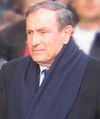
|
1991 1996 |
11 نوفمبر 1991 | 3 فبراير 1996 | 6 years, 84 days | Head of Executive | الحركة القومية الأرمنية |
| 2 | روبرت كوتشاريان (1954–) |
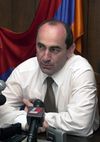
|
1998 2003 |
4 فبراير 1998 | 9 أبريل 2008 | مستقل | ||
| 3 | سرج سارگسيان (1954–) |
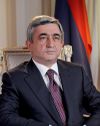
|
2008 2013 |
9 أبريل 2008 | 9 أبريل 2013 | الحزب الجمهوري | ||
| 4 | أرمن ساركسيان (1952–) |
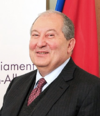
|
2018 | 9 أبريل 2018 | 1 فبراير 2022 (Resigned) |
3 years, 298 days | State representation, Guarantor of Constitution |
مستقل |
| – | Alen Simonyan (1980–) |

|
– | 1 فبراير 2022 | 13 مارس 2022 | 40 days | العقد المدني | |
| 5 | ڤاهاگن خاتشاتوريان (1959–) |

|
2022 | 13 مارس 2022 | الحالي | 3 years, 15 days | مستقل |
الانتخابات الأخيرة
| المرشح | الجولة الأولى | |||
|---|---|---|---|---|
| الأصوات | % | |||
| أرمن ساركسيان | 90 | 85.71 | ||
| أصوات غير صالحة/باطلة | 1 | 0.95 | ||
| ممتنعون | 10 | 9.52 | ||
| الإجمالي | 101 | 96.19 | ||
| الناخبون المؤهلون | 105 | 100 | ||
| المصدر: رويترز | ||||
الجوائز الرئاسية
